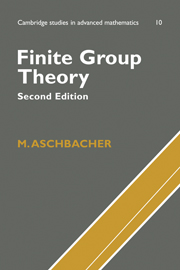Book contents
- Frontmatter
- Contents
- Preface
- 1 Preliminary results
- 2 Permutation representations
- 3 Representations of groups on groups
- 4 Linear representations
- 5 Permutation groups
- 6 Extensions of groups and modules
- 7 Spaces with forms
- 8 p-groups
- 9 Change of field of a linear representation
- 10 Presentations of groups
- 11 The generalized Fitting subgroup
- 12 Linear representations of finite groups
- 13 Transfer and fusion
- 14 The geometry of groups of Lie type
- 15 Signalizer functors
- 16 Finite simple groups
- Appendix
- References
- List of Symbols
- Index
8 - p-groups
Published online by Cambridge University Press: 05 June 2012
- Frontmatter
- Contents
- Preface
- 1 Preliminary results
- 2 Permutation representations
- 3 Representations of groups on groups
- 4 Linear representations
- 5 Permutation groups
- 6 Extensions of groups and modules
- 7 Spaces with forms
- 8 p-groups
- 9 Change of field of a linear representation
- 10 Presentations of groups
- 11 The generalized Fitting subgroup
- 12 Linear representations of finite groups
- 13 Transfer and fusion
- 14 The geometry of groups of Lie type
- 15 Signalizer functors
- 16 Finite simple groups
- Appendix
- References
- List of Symbols
- Index
Summary
Chapter 8 investigates p-groups from two points of view: first through a study of p-groups which are extremal with respect to one of several parameters (usually connected with p-rank) and second through a study of the automorphism group of the p-group.
Recall that if p is a prime then the p-rank of a finite group is the maximum dimension of an elementary abelian p-subgroup, regarded as a vector space over GF(p). Section 23 determines p-groups of p-rank 1, p-groups in which each normal abelian subgroup is cyclic, and, for p odd, p-groups in which each normal abelian subgroup is of p-rank at most 2. Perhaps most important, the p-groups of symplectic type are determined (a p-group is of symplectic type if each of its characteristic abelian subgroups is cyclic).
The Frattini subgroup is introduced to study p-groups and their automorphisms. Most attention is focused on p′-groups of automorphisms of p-groups; a variety of results on the action of p′-groups on p-groups appear in section 24. One very useful result is the Thompson A × B Lemma. Also of importance is the concept of a critical subgroup.
Extremal p-groups
In this section p is a prime and G is a p-group.
The Frattini subgroup of a group H is defined to be the intersection of all maximal subgroups of H. Φ(H) denotes the Frattini subgroup of H.
- Type
- Chapter
- Information
- Finite Group Theory , pp. 105 - 116Publisher: Cambridge University PressPrint publication year: 2000



